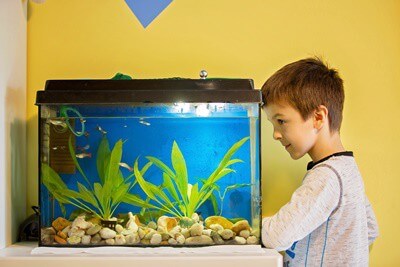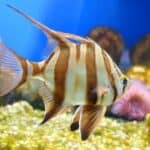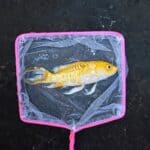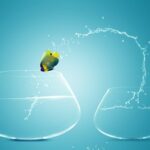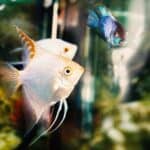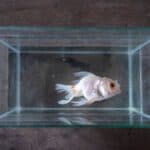A pet fish owner must choose a tank that allows fish enough space to grow and swim.
Fish can die if they’re housed in tanks that are too small. They’re at risk of stunted growth, aggressive tankmates, stress, ammonia poisoning, and reduced oxygen levels.
Fish develop several bacterial diseases due to low water quality. Overcrowding is a problem in small tanks, as is choosing fish that grow large without making adjustments.
When choosing the tank size, consider what fish you plan to get.
What Happens If Your Fish Tank Is Too Small?
Fish that don’t have enough room to swim or grow suffer from a shortened lifespan due to severe health and behavioral issues from their environment.
If in doubt, always opt for a larger tank, as it gives the fish more room to live.
Similarly, it’s easier to fill a tank with more fish than to reduce the population.
If the fish tank is too small, expect the following problems:
Stunted Growth
Does a small fish tank stunt fish growth? Many owners believe that fish grow to the size of the tank. While this isn’t strictly true, a small tank limits a fish’s ability to grow appropriately.
“Stunted” means that fish aren’t able to fulfill their species’ size potential.
They also don’t grow at the right speed. Most stunting occurs without the owner noticing, so it’s difficult to tell when fish are experiencing stunted growth without expert advice.
A fish’s growth is determined by somatotropin. As described by Creative Diagnostics, somatotropin is a hormone that controls growth. It tells fish when to gain mass and is stimulated by exercise.
When tanks don’t have enough space for fish to exercise, hormone production decreases.
Similarly, in an overcrowded tank, the feedback loop of hormones stops fish from growing. It also delays reproduction and weakens the immune system.
As well as the right size tank, fish need the following to grow:
- A high-quality diet.
- Enough food.
- Good water conditions.
- Suitable tankmates.
- Mental stimulation.
Fatty Liver Disease
Also known as hepatic lipidosis, fatty liver disease is common in adult fish whose growth rate has slowed. As mentioned, a small tank is a contributory factor.
Fatty liver disease is when excess fat coats the liver, preventing the organ from functioning correctly. They’ll refuse to eat as their digestive system starts to shut down. Left untreated, it causes death.
Aggression
Small tanks make fish aggressive because there’s not enough space to swim.
Some fish species are territorial and will fight each other for territory, especially if there are few plants and decorations to claim.
When fish fight each other, you’ll notice the following:
- Tears around the mouth and fins.
- Missing scales.
- Damaged eyes.
- Dislocated jaws.
Some fish fare worse than others, especially if they’re smaller and more submissive than their tankmates. Dominant fish will bully them to gain territory.
In turn, small tanks don’t have enough space for plants, meaning there are fewer hiding spaces for fish to hide in to protect themselves.
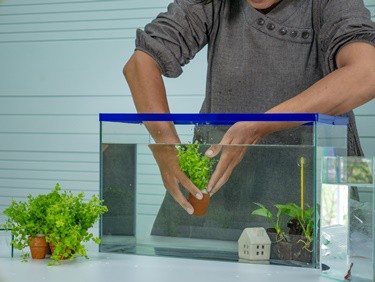
Poor Water Quality
Fish tank water quality problems are inevitable when the aquarium is too small. Small tanks prevent the nitrogen cycle from working efficiently, causing:
Ammonia
Putting fish into small tanks results in increased levels of ammonia. Ammonia (NH3) is a nitrogenous waste. It’s present in all tanks, but beneficial bacteria convert it into nitrite.
A second bacteria converts nitrite into nitrate, which is cleared from the tank by water changes. At elevated levels, ammonia poisons fish and causes them to become unwell or die.
Ammonia is caused by fish excrement and urine.
When the tank’s the right size for the number of fish, this isn’t a problem. Then, too many fish are crammed into a small aquarium, and large amounts of fish waste allow ammonia to infiltrate the tank.
The symptoms of ammonia poisoning include:
- Fish gasping at the water’s surface.
- Lethargy.
- Lack of appetite.
- Red or cloudy eyes.
- Redness around gills.
- Poor scale quality.
- Foul odor.
Choose the right size tank for the number of fish to prevent ammonia from rising to dangerous levels.
Not Enough Oxygen
Fish need oxygen to survive, as it helps keep the respiratory system working efficiently. Fish tanks also need oxygen to break down waste and remove harmful chemicals from the water.
Similarly, live aquarium plants require oxygen. Without it, they decompose and raise ammonia levels.
Tanks with a larger surface area have more oxygen, as the gas exchange is more efficient. The tanks should also be wide enough to provide the oxygen they need.
Stress
According to Aquatic Veterinary Services, chronic stress is caused when fish can’t swim freely.
Poor water quality, over-crowing, and aggressive fish caused by a small tank are all leading causes of stress. Stress is among the main reasons for most health and behavioral conditions in fish.
The signs of stress include:
- Strange swimming patterns.
- Gasping at the surface.
- Decreased appetite.
- Diseases, such as ich.
- Poor scale quality.
Mild stress is something fish can recover from, but if a small tank isn’t swapped for a larger one quickly enough, they can get ill from the stress or die.
How Do I Know If My Fish Tank Is Too Small?
Many new owners make the mistake of choosing a starter tank, which is often too small for their fish’s requirements. As a result, their fish quickly outgrow their living space.
Here are the most noticeable signs the tank is too small:
Lack of Swimming Space
If you notice the fish aren’t swimming as much as you’d expect, it’s likely because there’s not enough room in the tank.
If this is the case, the fish will swim sideways or remain at the bottom of the tank. Similarly, they may float at the water’s surface.
If there isn’t enough room in the tank for fish to swim comfortably, they’ll begin to chase each other out of frustration. Fish that hide more often try to get out of the way of other fish.
As a result, increased or unusual activity indicates something amiss in the tank. If fish can swim from one end of the tank to another in a single motion, the tank is too small.
Loss of Appetite
Stressed or unhappy fish will stop eating. This is a common reaction to poor tank conditions.
Both result from a small tank, which is a severe problem. When fish stop eating, they’re alerting you that something’s wrong. In this case, the tank’s too small.
Feeding times can also be stressful in a small tank. Fish don’t feel safe enough to eat when they’re too close to other territorial fish. Stress is also the leading cause of appetite loss.
Not only is inappetence a problem, but uneaten food festers and rots at the bottom of the tank, causing harmful ammonia levels to rise and decreasing the water quality.
Diseases
Diseases occur due to stress or improper water conditions.
Common health conditions and diseases that are the result of a small tank include:
- Ick occurs due to a parasite.
- Dropsy is a bacterial infection of the kidneys.
- Fin rot is a bacterial infection that causes the tail and fins to fray.
- Pop eye is a bacterial infection of the eye.
- A clamped fin is the result of an infection or parasite.
- Red or white sores are usually the result of fish fighting.
Fungal and bacterial infections are also common when the tank is too small and incorrectly set up.
What Size Fish Tank Do I Need?
All fish need different tank requirements. Unfortunately, there’s no one-size-fits-all solution.
The tank size you’ll need depends on how many fish you have. You’ll also need to perform some research to work out whether your chosen fish prefers wider or taller tanks.
To work out the right size tank for the fish, use one of these popular measuring methods:
One Inch Per Gallon
The most popular way to calculate the appropriate tank size is with the one-inch per gallon rule.
This measurement assumes that a tank can hold one inch of fish per gallon of water and uses the fish’s length as the primary measurement.
While this method is a handy rule of thumb, there’s still a risk that the tank could become too small. This is because many owners forget to account for plants and ornaments.
It also doesn’t take into account the fish’s height. As a result, measure the plants and any decorations and account for them as part of the tank to ensure enough swimming space.
Another method is to work out your fish’s height and add 10 gallons of water for every fish.
One Inch Per Two Gallons
Not all owners like the one-inch-per-gallon rule because it can lead to overstocking if incorrectly calculated. The one-inch-per-two-gallon rule is better for growing fish, reducing the risk of stunted growth.
The concept is the same as the one-inch per one-gallon rule, but it allows fish more swimming space. It also means the water quality stays better for longer, requiring fewer changes.
When using this calculation, measure the size of your plants and ornaments, leaving ample space for fish to swim and grow.
Aquarium Floor And Surface Area
The best way to find the right tank size is by calculating the aquarium’s floor space and surface area.
This method provides more room for plants and fish and a more expansive tank floor. This can help prevent aggression and low water quality within the aquarium.
Our calculation is based on fish requiring 12 square inches of surface space, but you can adjust this to suit the size of your fish.
To get your calculation, follow these steps:
- Measure the length and width of the tank and multiply the two to determine the surface area.
- Divide the surface area by 12 to give you the total inches of fish the tank can hold.
- Divide the number by 12, which is the height of the fish.
Why Is My Small Fish Tank Cloudy?
Few fish tanks have crystal clear water, but cloudiness indicates a problem within the aquarium. The best way to prevent your tank’s water from going cloudy is to provide a large enough tank.
Reasons for murky water are linked to a tank that’s too small. This includes:
Bacteria
The most common cause of cloudy water is a “bacteria bloom.”
When ammonia and nitrites build up within the tank, aerobic bacteria establish themselves. As it floats through the water, a cloudy appearance occurs.
An increase in ammonia causes a bacteria bloom. This is usually the result of uneaten, decomposing food, which provides nutrients for the bacteria to grow.
The tank’s filtration system also can’t clean the bacteria quickly enough, causing it to multiply.
Overcrowding
If there’s not enough room for all the fish you have inside the tank, the water’s quality degrades. Fish create excess waste that fills the tank too quickly, causing the filtration system to work too hard.
Because a tank is a closed ecosystem with no water, the water quality deteriorates in a small tank, making it cloudy. Similarly, if water changes aren’t carried out enough, the water will get dirtier.
Small tanks require more water changes, which owners often neglect.
Algae
A sudden spike in fish waste causes algae to multiply, covering the tank’s plants and glass while causing the water to turn murky and opaque.
Fish waste acts as a fertilizer for algae.
Too much in a small space makes algae grow out of control. Algae also require the same nutrients as bacteria to grow, so a cramped tank provides the optimum conditions for an algae bloom.
Aside from too many fish in a tank, too much light and overfeeding cause algae overgrowth.
Are Small Fish Tanks Bad?
Fish tanks that are too small are far worse than tanks that are too big. Large tanks allow space to grow, whereas small aquariums offer cramped conditions that no fish can thrive in.
Another problem with small tanks is that difficulties escalate. The small volume of water that fish have to live in experience sudden water chemistry and temperature changes, which can be fatal.
You must carry out water changes more regularly to keep the tank clean of harmful chemicals. If this step is neglected, ammonia and nitrite could rise without warning.

Easiest Fish To Keep Alive In A Small Tank
When looking for fish suitable for a small tank, you must choose fish that won’t grow too large.
For example, goldfish are seen as a good choice, but they grow surprisingly big. They outgrow many starter tanks. As a result, consider the following small fish for your tank.
Bloodfin Tetra
Also known as the true bloodfin, bloodfin tetra is a freshwater fish that’s easy to care for, making it popular with beginners. They grow to a manageable two inches long, surviving 5-7 years.
The bloodfin tetra fish has a silver body with a bright green tail and fins. The minimum tank size is 10-20 gallons, depending on how many you have.
Bloodfin tetra prefers living in schools of around 5-7 fish. They swim in groups in the upper and middle sections of the tank and love lush, live vegetation replicating their natural South American habitat.
Guppy
The guppy fish is also known as the millionfish and rainbow fish. It’s among the most popular tropical freshwater fish species, adding color to the tank. They’re also easy to look after.
Male guppies range from 0.6-1.4 inches in length, while females are slightly larger, reaching 1.2-2.4 inches. Guppies thrive in groups of six with a ratio of two females for each male.
Because they’re so small, guppies don’t need much space to live in. However, the recommended tank size provides four gallons of water for a group of three guppies.
When adding more to the tank, opt for:
- 4 gallons of water for 3 guppies.
- 6 gallons of water for 6 guppies.
- 9 gallons of water for 9 guppies.
Platy
Platy is another freshwater fish species. They’re peaceful and easy to care for, making them ideal for beginner fish owners.
Males reach around 1.5 inches in length, while females grow up to 2.5 inches. Both males and females live for approximately 3-5 years.
While platies are small, they’re active, so they need enough space to swim.
Platies thrive in a 10-20 gallon aquarium. They can also tolerate a wide pH range of 6.8-8.5, so they’re adaptable to their conditions.
Platies are native to Central and North America and do well in a tank that contains plants.
Platies aren’t schooling fish, so they shouldn’t be kept in groups of more than five. The ideal ratio is one male to three females.
White Cloud Mountain Minnow
White cloud mountain minnows are small, colorful fish. They reach 1.5 inches and live 3-5 years.
White Cloud Mountain minors enjoy living in schools of up to 12 fish. They don’t like being alone. As a result, they lose their color and spend most of their life hiding out of stress.
The minnow is undemanding regarding their tank conditions, but they don’t do well in temperatures about 72 F.
Zebrafish
Zebrafish are a favorite freshwater fish with beginner fish owners because of how easy they are to care for. Zebrafish are defined by their black and white stripes.
As adults, zebrafish grow to two inches. While they only need a 10-gallon tank, they’re prolific breeders, so they must be monitored to ensure they don’t multiply too quickly.
They thrive in schools and also make peaceful community fish alongside other species.
Small tanks are bad news if you plan to fill them with plenty of fish and plants. Not only can they cause a range of physical health problems, but they cause depression and anxiety.
Choose a tank that fits your fish’s size requirements and allows them to grow and swim comfortably.

